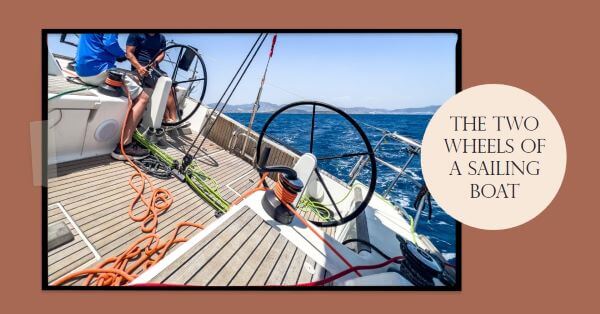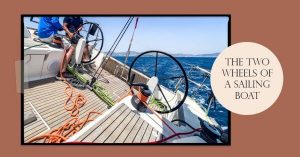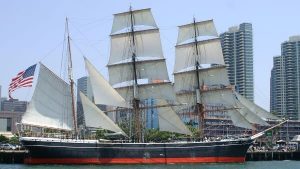Majestic sailing boats, with their billowing sails, are a sight to behold. But why do they have two wheels? It is for their intricate mechanics and design.
These boats sail through the sea and two wheels make them easier to maneuver and control. These two wheels are called helms or steering wheels and are usually on opposite sides of the cockpit. This helps the sailors to steer the boat in any direction - upwind or downwind.

Why not just one wheel? Having two has several advantages. Firstly, it provides better balance and stability as the weight is spread evenly. It also reduces the risk of capsizing.
It also reduces strain and fatigue on the sailor as steering duties can be shared between crew members. This is especially important during long voyages.
Two wheels also enable swift and precise adjustments when tacking or jibing - maneuvers needed to change direction against the wind. This helps the sailors quickly shift from side to side without disrupting their progress.
In order for dual-wheel systems to work properly, communication between crew members is vital. They must stay in constant communication to make sure everyone knows the wheel's position and how it affects the sail trim.
Table of Contents
- Explanation of the two wheels on sailing boats
- Purpose and benefits of having two wheels
- The functionality and role of each wheel
- Factors to consider when using the wheels
- Techniques and tips for effectively using the wheels
- Safety precautions and recommendations
- Conclusion
- Frequently Asked Questions
Explanation of the two wheels on sailing boats
Have you ever asked why sailing vessels have two wheels? It's because of the precision and complexity needed to control them.
The two wheels give redundancy, so if one fails, the boat can still be steered. This is very important in off-conditions where a mistake can be bad. The wheels also give better weight distribution and balance, allowing sailors to make changes quickly and without shaking the boat.
But there's more to it. Based on wind direction, each wheel has a specific use. The leeward wheel, on the side opposite to the wind, helps when sailing downwind. It allows the helmsman to stay in control and see the sails, reducing friction when steering into the wind.
When upwind or close-hauled, it's the windward wheel that takes charge. It gives mechanical advantage when changing direction into or through the wind. By using both wheels strategically, sailors can get the best performance and navigate skillfully.
Purpose and benefits of having two wheels
Sailing boats have two wheels for various purposes and benefits. These include:
- Better control and maneuverability: Dual-wheels give sailors more exact control, especially in windy or complex conditions.
- Redundancy for safety: Two wheels provide a back-up if one fails or is inaccessible.
- Improved visibility: Two wheels offer a bigger field of vision, to observe obstacles better.
- Enhanced balance and stability: Sharing power between wheels helps balance and stability when sailing.
- Multitasking capabilities: Two wheels let crew members divide helm tasks efficiently.
Plus, dual-wheel configurations often feature mechanical or hydraulic systems with extra advantages.
An example of two wheels' importance is this story: During an ocean race, a squall suddenly hit the yachts. The wind got strong and one boat had a steering wheel malfunction. With two wheels, they shifted control swiftly and kept control in the storm, winning the race.
The functionality and role of each wheel
Let's take a closer look at the table below to understand the functionality and role of each wheel:
| Wheel | Function |
|---|---|
| Main Wheel | Responsible for steering the sailboat by turning the rudder. |
| Secondary Wheel | Ensures effective adjustment of sail position to maximize sailing efficiency. |
Interesting! These two wheels work together harmoniously, yet serve different purposes. The Main Wheel focuses on steering, while the Secondary Wheel adjusts the sails based on wind direction and strength. This makes sailing smoother.
Here are a few suggestions to enhance these functionalities further:
- Integrate modern navigation systems that give real-time data on wind patterns, sea conditions, etc. This helps sailors make informed decisions when maneuvering.
- Design ergonomic control panels around both wheels. This would reduce fatigue and enhance focus, contributing to a safer and better performance.
By using advanced technologies and ergonomic considerations, sailors can navigate their vessels with greater control and efficiency. Enjoy the exhilarating yet safe sailing experience on these remarkable watercrafts!
Factors to consider when using the wheels
Let's check out some extra important details. Monitor waves, understand sail dynamics, and adjust rudder angles - all these are key.
A sailor experienced tough waters with strong winds. With wise wheel handling and wind adjustments, he made it through the waves and arrived safely. Amazing!
Techniques and tips for effectively using the wheels
Wheeling a sailing boat skillfully takes finesse and practice. Check out these techniques and tips to ace it:
| Technique | Tips |
| 1. Leverage Wind Direction | Angle the wheels according to the wind's direction for optimized speed. |
| 2. Balance Steering | Keep a steady balance between the two wheels for control and maneuverability. |
| 3. Coordinate with Crew | Communicate well with crew members to sync wheel movements for efficient navigation. |
For more in-depth info, here are extra details: Utilize adjustments in wheel placement to exploit the wind force and stay on course. This will assist the boat in gliding smoothly through varying water conditions, without any resistance or turbulence. Tiny tweaks can make a huge difference in performance.
Expert Tip: Practicing and gaining hands-on experience is the key to acing the art of using sailing boat wheels effectively. Keep learning, adapt to different scenarios, and always aim for smooth sailing!
Safety precautions and recommendations
Always wear a life jacket when on board for your safety. Check the weather before setting sail to avoid storms and wind. Monitor the boat's weight distribution to prevent capsizing. Inspect and maintain equipment, including sails, rigging, and navigation instruments, to ensure they are working. Stay alert for other vessels and use signals if needed. Have proper communication onboard, using VHF radios or marine mobile phones.
Also, adhere to local maritime regulations. Be aware of obstacles such as reefs or shallow waters. To improve safety, take a training course or join a sailing club. Check the tide tables and navigation charts for your trip. Before departing, let someone ashore know your itinerary. Follow these precautions for a safe and enjoyable sailing experience!
Conclusion
Sailing boats are equipped with two wheels. These enable sailors to precisely control the direction of the boat. This makes navigation easy in different wind and water conditions, for a smoother and safer sailing experience.
Having two wheels provides backup. In case one wheel malfunctions or is blocked, the boat can still be controlled effectively. Additionally, two people can steer the boat at the same time, improving teamwork.
The double wheels also improve visibility. The helmsman has a clear view of the sails, crew, and obstacles ahead. This helps them make quick decisions and adjust sails according to changing wind conditions. And, the design reduces strain on the helmsman's body.
Don't miss out on this amazing experience! Combining nature's elements with human ingenuity, set sail today and experience the thrill and efficiency of a sailing boat with dual-wheel systems. Enjoy breathtaking views of vast blue waters while controlling the vessel through wind alone.
Frequently Asked Questions
Q: Why do sailing boats have two wheels?
A: Sailing boats have two wheels to allow for better control and steering. Having two wheels allows the helmsman to easily switch sides and maintain balance while sailing.
Q: Do all sailing boats have two wheels?
A: No, not all sailing boats have two wheels. Smaller sailboats or those with simpler designs often have only one wheel or tiller for steering.
Q: What are the advantages of having two wheels on a sailing boat?
A: The main advantage of having two wheels is redundancy. In case one wheel malfunctions or becomes obstructed, the other wheel can be used for steering, ensuring the safety of the boat and its crew.
Q: Can both wheels on a sailing boat be used simultaneously?
A: Yes, both wheels on a sailing boat can be used simultaneously. This can be beneficial in certain situations, such as when sailing in strong wind or rough sea conditions, as it allows for better distribution of control and leverage.
Q: Are there any drawbacks to having two wheels on a sailing boat?
A: One potential drawback of having two wheels is the increased complexity of the steering system. This can make maintenance and repairs more complicated compared to boats with a single wheel or tiller.
Q: What types of sailing boats typically have two wheels?
A: Larger sailing boats, such as cruisers, racing yachts, and catamarans, commonly have two wheels. These boats often have a spacious cockpit and require the extra control and maneuverability provided by dual steering wheels.
Read the Latest History of Sailing Posts:
- What does rough sailing ahead mean?
- Why do Sailing Boats have Two Wheels?Majestic sailing boats, with their billowing sails, are a sight to behold. But why do they have two wheels? It is for their intricate mechanics and design. These boats sail through the sea and two wheels make them easier to maneuver and control. These two wheels are called helms or steering wheels and are usually… Read more: Why do Sailing Boats have Two Wheels?
- Why are Sails Black in Sydney to HobartBlack sails are often used in Sydney to Hobart races due to their UV-resistant properties. Carbon or Kevlar laminates are UV-stable, which reduces wear over the course of a long race, and these materials are typically black. If you read on I'll give far more information on black sails and why they're so popular. Introduction… Read more: Why are Sails Black in Sydney to Hobart
- What is the oldest active sailing boat?The oldest active sailing boat is believed to be the "Star of India." The Star of India is a fully rigged iron-hulled ship that was built in 1863. Originally known as the Euterpe, it was used for transporting emigrants to New Zealand and then served as a cargo ship in various trades, including the jute… Read more: What is the oldest active sailing boat?
- How did Sailing Ships Repair their Masts at Sea?Introduction Sailing ships had to battle many difficulties on the seas, like repairing their masts, which was no easy task. To do this, they'd make a 'jury mast' with spare wood from the ship. Or they'd fix a pole across the deck and hoist the broken mast for repair. Some captains even had pre-made masts… Read more: How did Sailing Ships Repair their Masts at Sea?






